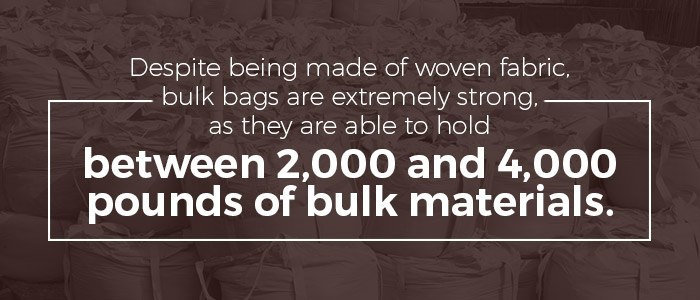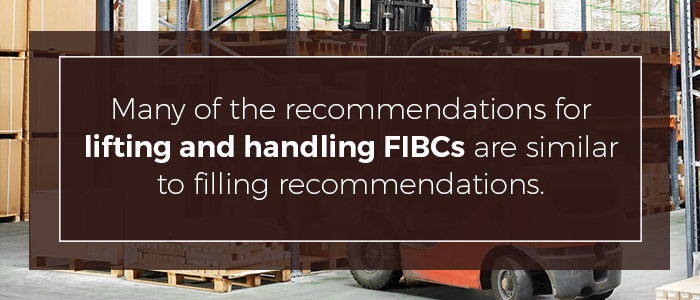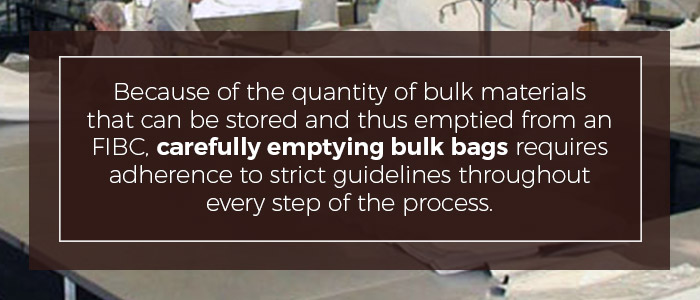Flexible intermediate bulk containers, also known as FIBC bulk bags, are rapidly making bulk material shipping easier and more cost effective.
Despite being made of woven fabric, bulk bags are extremely strong, as they are able to hold between 2,000 and 4,000 pounds of bulk materials. In fact, FIBCs are prized for their superior package-to-product weight ratio which is estimated to be five to seven pounds per metric ton.

However, for those looking to incorporate FIBCs into their shipping operation, there are important things to keep in mind. Because bulk bags must meet high demands with regard to strength and durability, it is essential for shipping operations to become familiar with how to handle and how to store FIBC bulk bags properly. While FIBCs have been proven to be as durable as their more solid counterparts, improper storage and handling can lead to significant, costly and potentially dangerous accidents. Like any product that must withstand high demands, FIBCs must be used in accordance with manufacturer recommendations and industry best practices.
That’s why we’ve put together this guide on safely handling and storing bulk bags. Our guide is based on the stringent criteria set down by the Flexible Intermediate Bulk Containers Association (FIBCA), the leading professional association for distributors, manufacturers and users of FIBCs. For a quick summary on the handling and storage of FIBCs, view the FIBCA’s video below:
How to Store Bulk Bags
Let’s begin with the issue of correct storage. While you can buy bulk bags either new or used, it is important to store them properly to ensure their strength and longevity.
There are two elements you should protect your FIBCs from:
• UV rays: While the woven polypropylene that makes up bulk bags is extremely durable, over time, exposure to UV rays can start to weaken the fabric. Remember, many bulk bags are expected to lift up to 4,000 pounds. Polypropylene is a reliable material, but you want to avoid anything that could potentially weaken a material expected to bear over a ton of weight.
• Inclement weather: Storms, rain and snow can all gradually weaken the strength of your bulk bags over time. Additionally, you should make sure you are storing any unused bulk bags in a place that is free of significant indoor moisture since exposure to even general moisture can eventually degrade the quality of your bags.
It’s also important to make sure your bags are being stored inside. The FIBCA does not endorse or support any form of outside storage, even if that storage location is free from moisture and UV rays.
FIBCs are so useful because they are light and flexible, making them easy to store and maneuver when not in use. However, for them to provide this type of flexibility, FIBCs are made with strong materials that are nonetheless subject to weathering if not stored properly.
It is also worth noting that as of the moment, there is no significant data on the expected shelf lives of FIBCs. Because of the number of factors that can contribute to FIBC strength degradation, it’s important to follow manufacturer recommendations and regularly subject your FIBCs to strength tests. If you test samples of your used FIBCs and compare the results with new FIBCs, you will be able to determine if any measurable change in quality has taken place.
How to Properly Fill Bulk Bags
Storing FIBCs properly is a crucial best practice for extending the life of your bulk bags while simultaneously ensuring their quality, but it’s also imperative to follow proper filling procedures.
Again, it is important to remember throughout every step in this process just how much weight an FIBC is designed to bear. It may seem like a bag would only handle light loads, but FIBCs are designed to carry up to 4,000 pounds of weight. A potential accident caused by improper filling procedures should be avoided at all costs. Here are some ways to ensure proper filling of your bag:
- Start by ensuring the FIBC is visually free from any damage that may compromise its strength or carrying ability. If you see a rip, a loose seam or any other deformity, do not attempt to fill the bulk bag. It should be removed and given a thorough inspection before being used again.
- Next, make sure the discharge chute on the bottom of the bag is closed properly in accordance with manufacturer recommendations.
- You also want to ensure you are attempting to fill the bag with an approved bulk product. Do not use FIBCs to carry unapproved materials.
- As you fill the FIBC, make sure the product is filling the bag evenly and that the bag is remaining stable as it is being filled.
- You also need to make sure any device used to suspend the FIBC is rated as capable of bearing the anticipated weight of the bag and its contents and ensure the bag is being suspended as per manufacturer instructions, utilizing all lift loops and sleeves. Additionally, all lift loops should be held vertically to avoid potentially damaging lateral forces.
- It is also imperative that all lifting mechanisms, whether they be crane hooks, bars or fork lift tines, are free from protrusions or any other sharp edges that may potentially cut or tear the lift loops on the FIBC. All lifting mechanisms must have rounded edges with a radius of at least five mm.
- After filling your FIBC, ensure the fill spout is closed as per manufacturer instructions. When lifting and moving the bulk bag, make sure it’s done so in a fluid motion to avoid tipping or ripping.
- Be mindful of the environment when filling your bulk bag, paying particular attention to any electrostatic or flammable concerns.
- Control dust appropriately.
- Ensure all personnel remain at a safe distance when moving an FIBC.
- Follow any other instructions or advisories printed on the FIBC by the manufacturer.
There are also a number of things you should always avoid when filling an FIBC bulk bags:
- Never fill an FIBC with a non-approved product.
- Never fill an FIBC without verifying the bottom spout is closed.
- Never fill an unstable FIBC — or fill one in a way that causes it to become unstable.
- Never exceed the rated working load of either the bag or the carrying apparatus that is holding the bag.
- Never use a device to support your FIBC that is not approved to do so.
- Never suspend an FIBC with a hook without an approved safety latch.
- Never move an FIBC with a jerky or sudden motion.
- Never attempt to lift an FIBC when the lift loops are not in a vertical position.
- Never fill an FIBC within a dangerous filling environment.
- Never place any part of your body under a suspended FIBC.
If you follow these instructions and are mindful when working around an FIBC, you will find it’s an efficient and safe way to load and transport bulk materials.
How to Lift FIBCs

Many of the recommendations for lifting and handling FIBCs are similar to filling recommendations. However, because of the risk of significant injury due to the weight being carried by an FIBC, they bear repeating:
- Make sure the FIBC is free from visible damage before moving it.
- Be certain any cranes and lifting mechanisms are rated to bear the weight of a filled FIBC.
- Only use hooks, bars and fork lift tines that are free of protrusions and have rounded edges with a radius of at least five mm.
- Use lifting mechanisms that are approved for lifting FIBCs.
- Make sure lifting loops on the FIBC are vertical before lifting to avoid dangerous lateral motions.
- Only move an FIBC that is hanging in accordance to manufacturer recommendations, including being held by all loops and sleeves.
- Move the FIBC using a fluid motion.
- Make sure all sight lines are clear and the area is free of obstructions when moving an FIBC.
- Ensure all personnel stand well clear of the moving FIBC.
- Follow any additional instructions or recommendations printed on the FIBC by the manufacturer and also ensure you following industry safety guidelines.
There are also a number of things to be sure to avoid when lifting or moving an FIBC:
- Never move a damaged FIBC.
- Never move an FIBC that exceeds the rated lifting capacity of your lifting mechanism.
- Never attempt to move an FIBC with a device that is not approved or designed to move an FIBC.
- Never move an FIBC on which the lift loops are not vertical.
- Never gather lift loops onto one hook unless the specific FIBC is designed to do so.
- Never lift or move an FIBC without lifting every loop or sleeve.
- Never lift or move an FIBC using a sudden, jerking motion.
- Never attempt to move an FIBC around or over an obstruction.
- Never move an FIBC over personnel and don’t let personnel travel under a moving FIBC.
- Never handle an FIBC in an unapproved way.
A fully loaded FIBC will be extremely heavy, and it can be dangerous if not handled properly. It is imperative to handle FIBCs with care and in accordance with FIBCA indicated best practices and manufacturer recommendations.
Storing and Transporting Filled FIBCs

FIBCs are becoming popular because they are small and flexible when empty, yet they are easy to store and transport when filled. However, like all steps in the FIBC filling and handling process, storing and transporting FIBCs requires attention to detail and strict adherence to industry best practices and manufacturer recommendations. Here’s what we mean:
- Start with a visual inspection to ensure filled FIBCs are free from any damage that might compromise their strength.
- Always ensure FIBCs are stable before stacking.
- Always use a pyramid or supported stacking method. In a pyramid stack, each bag above the first layer is resting equally between four lower backs, thus creating a pyramid. Supported stacking uses at least two retaining walls that are sufficiently strong to support stacked bags.
- Make sure pallets are larger than the base of the bag when stacking bags on pallets.
- Place bags gently when stacking.
- Secure all FIBCs when transporting them.
- Adhere to both manufacturer recommendations and industry safety standards during storage and transportation.
- Make sure you are storing FIBCs in a dry and UV-free indoor storage facility.
- Cover FIBCs to protect them from dirt, moisture and UV rays.
In addition to these best practices for storing and transporting your FIBCs, there are also a number of things you’ll want to avoid:
- Never stack FIBCs that appear unstable.
- Never try to handle or repair a damaged bag that still has other bags stacked on top of it.
- Do not allow an FIBC to extend past the end of a pallet unless that bag is specifically designed to do so.
- Never suddenly lift or drop an FIBC.
- Never transport an FIBC that is not secured.
- Never use unapproved methods for handling or transporting an FIBC.
- Never violate safety regulations.
- Never expose your FIBC to UV light, inclement weather or consistent moisture as this may damage the FIBC, thus increasing the risk of accident and injury. It is never recommended to store an FIBC outside.
FIBCs are easy to store and transport. However, that doesn’t mean you can do so without care. Make sure to follow all recommendations from both the FIBCA and the manufacturer to ensure transportation is done safely.
How to Empty Your FIBC

Eventually, you will need to empty your bag, and it’s just as important to safely empty your FIBC as it is to fill, store and transport it. Because of the sheer quantity of bulk materials that can be stored and thus emptied from an FIBC, carefully emptying bulk bags requires adherence to strict guidelines throughout every step of the process:
- Make sure your FIBC is free from damage before initiating the emptying process.
- Inspect the surrounding environment to make sure it’s safe for emptying. Pay special attention to electrostatic risks in flammable areas.
- Only use approved devices for handling a full FIBC. This includes ensuring that your apparatus is rated to handle the weight of a full FIBC.
- Only use approved hooks, bars and forklift tines to suspend a full FIBC. These tools should be rounded and free of protrusions, with the rounded edges meeting a minimum measurement of 5 mm.
- Lower the FIBC into position smoothly.
- As you lower your FIBC, make sure the lift loops on the bulk bag maintain their vertical position.
- Make sure all lift loops or sleeves are being used when emptying your FIBC.
- Make sure personnel are standing well clear of the emptying FIBC.
- Take any and every appropriate measure to control dust.
- Empty your FIBC in accordance with printed manufacturer recommendations while maintaining any industry specific safety standards.
Because of the significant risk of injury and property damage, there are a number of things you should avoid when performing the FIBC emptying procedures as well:
- Never attempt to empty a damaged FIBC without direct instructions from the manufacturer.
- Never empty an FIBC into a potentially high risk environment.
- Never attempt to empty an FIBC using a non-approved lifting device.
- Never drop or move an FIBC using a jerking motion.
- Never employ a hook without a safety latch to suspend an FIBC.
- Never hang an FIBC using a single hook to gather lifting loops unless this is in accordance with the specific design of an FIBC.
- Never hang an FIBC in way that does not employ every loop or sleeve on the bulk bag.
- Never hang an FIBC above personnel nor let personnel to walk beneath and FIBC. No personnel should place any part of their body under an FIBC.
- Never attempt to lift or suspend an FIBC if the lift loops are in a non-vertical position.
- Never ignore printed instructions nor use an FIBC in a manner that is not approved by the manufacturer or goes against best practices as dictated by the FIBCA.
By adhering to this guide to emptying your FIBC, you will be able to reap all the benefits in efficiency and cost that come from bulk bags while maintaining a safe working environment for your personnel.
Store and Transport Materials with FIBCs from Midwestern Bag
In conclusion, an FIBC is a wonderful tool for the collection, storage and transportation materials. Due to its superior package-to-product ratio, more and more companies are turning to bulk bags to handle their bulk materials. It’s no wonder then that 42 million bulk bags are used every year, demonstrating their effectiveness as a bulk material handling solution!
However, it’s also important to remember that like any great solution, the effectiveness and safety of an FIBC bag is contingent upon using it properly and in accordance with manufacturer recommendations. We hope this guide has helped you feel more confident in the value and techniques for using bulk bags in your own operation. Contact us today when you’re ready to order or if you need more information.
If you are ready to hear more about bulk bags or curious about how to incorporate the best FIBCs in the industry into your own operation, contact Midwestern Bag & Supply today. One of our courteous and knowledgeable sales representatives will be happy to help you find the perfect solution for your company!


 Copyright © 2025 Midwestern Bag. All Rights Reserved.
Copyright © 2025 Midwestern Bag. All Rights Reserved.